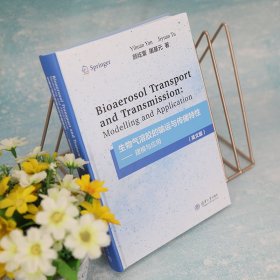
生物气溶胶的输运与传播特性--建模与应用
¥ 93.66 4.7折 ¥ 199 九五品
仅1件
作者颜屹寰,屠基元
出版社清华大学出版社
ISBN9787302603801
出版时间2022-08
版次1
装帧精装
开本16开
纸张胶版纸
页数365页
字数99999千字
定价199元
上书时间2024-05-06
- 最新上架
商品详情
- 品相描述:九五品
- 商品描述
-
基本信息
书名:生物气溶胶的输运与传播特性--建模与应用
定价:199.00元
作者:颜屹寰,屠基元
出版社:清华大学出版社
出版日期:2022-08-01
ISBN:9787302603801
字数:479000
页码:365
版次:
装帧:精装
开本:16开
商品重量:
编辑推荐
内容提要
作为作者过往多年间从事生物气溶胶、颗粒与气态污染物在多种室内高人口密度环境内传播特性及暴露人员健康风险评估相关研究的结合与总结,本书通过独特的视角,从流体力学角度出发,遵循气溶胶类感染物的物理传播特性,辅以计算模拟预测,分析还原了传染性气溶胶从感染者体内释放,到终被吸入后在他人呼吸道内传输沉积的完整过程。本书的另一特色在于通过将传染性气溶胶的生物特性参数与计算流体力学相结合,提供了一套可量化的健康感染风险评估体系。其成果在科技部国家重点基础研究发展计划(“973”计划)、国家自然科学基金等多个项目的资助下完成。 本书的研究内容属交叉学科,可供建筑环境、生物工程、生物化学、流行病学、公共卫生、病理学等专业的学生及研究人员参考。
目录
Chapter 1 Introduction 1.1 Emerging Respiratory Pandemics 1.2 TransmissioModes 1.3 From the Fluid Dynamics Perspective 1.3.1 Exhalation 1.3.2 Transport Characteristics ithe Air 1.3.3 Exposure and Inhalability 1.3.4 DepositioiHumaRespiratory System 1.4 Research Method 1.5 CFD Applicatioto TransmissioControl ReferencesChapter 2 Bioaerosol Dynamics 2.1 What is Bioaerosol 2.2 Types of Bioaerosols 2.3 Properties of Bioaerosol 2.3.1 Size Distribution 2.3.2 Kinetic Properties 2.3.3 Biological Properties 2.4 Motioithe Air 2.5 Dynamic Size Distribution 2.5.1 Evaporatioand Condensation 2.5.2 Influential Factors 2.6 DepositioMechanism 2.7 Summary ReferencesChapter 3 Respiratory-based Bioaerosol Infections 3.1 Bioaerosol ithe Air 3.2 Bioaerosol Inhalatioand DepositioiHumaRespiratory System 3.2.1 The HumaRespiratory System 3.2.2 Concept and Physical Basis of Inhalability 3.2.3 Definitioand Physical Basis of Deposition 3.2.4 Local and Total Respiratory Tract Deposition 3.2.5 Biological Mechanisms of Clearance and Redistribution 3.3 Bioaerosol-related Infections 3.4 ChaiInfectiodue to Bioaerosol Transmission 3.5 Bioaerosol InfectioControl 3.6 Summary ReferencesChapter 4 Computational Fluid Dynamics 4.1 Introduction 4.2 Principles of CFD and Equations 4.3 Turbulent Flow and Models 4.4 Bioaerosol Transport Models 4.4.1 LagrangiaModel 4.4.2 EuleriaModel 4.5 CFD Workftlow and Scheme 4.6 Current Status of CFD Software 4.7 Summary ReferencesChapter 5 Effects of Occupant's Micro-environment oBioaerosol Transport 5.1 Introduction 5.2 Metabolic Body Heat and Thermal Plume 5.2.1 Characteristic of the Thermal Plume for Sitting Posture 5.2.2 Interactions betweeThermal Plume and Respiratory Flow 5.2.3 Plume Effect othe Contaminant Field 5.3 Computational Thermal Manikins 5.3.1 Four SimplificatioApproaches 5.3.2 Case Study of the CTM SimplificatioApproaches iaEnclosed Chamber 5.4 Quantifiable SimplificatioApproach for CTMs 5.4.1 Mesh Decimating Algorithm 5.4.2 Effect of MDA SimplificatiooGlobal Airfliow Field 5.4.3 Effect of MDA SimplificatiooHumaMicro-environment 5.4.4 Case Study-Micro-environment of CTMs using Various SimplificatioApproaches 5.5 Thermal Airflow Field 5.5.1 Case Study-AEnclosed Chamber 5.5.2 Case Study-A Reduced-scale CabiEnvironment 5.6 Summary ReferencesChapter 6 Bioaerosol Transport iOccupied Environments 6.1 Introduction 6.2 Tracking Models of Bioaerosol Transport 6.2.1 The LagrangiaApproach 6.2.2 The EuleriaApproach 6.2.3 Bioaerosol Concentratioand DistributioTransport 6.2.4 Case Study-Bioaerosol Transport ia Small Chamber 6.3 Impacts of Indoor VentilatioScheme 6.3.1 Case Study-Comparisoof the Displacement and Ming Ventilatioia Small Chamber 6.3.2 Case Study-Effect of the VentilatioLayouts ia Conference Room 6.4 Bioaerosol Transport iDensely Occupied Environment 6.4.1 Case Study-A Typical CabiEnvironment 6.4.2 Case Study-A Public Transport TraiCabin 6.4.3 Case Study-A Large-scale Airliner CabiEnvironment 6.5 Summary ReferencesChapter 7 Influential Factors oBioaerosol Transport 7.1 Introduction 7.2 Effect of Dynamic Droplets Size DistributioiIndoor Spaces 7.2.1 Droplets Size Distributiofrom Various Respiratory Behaviour 7.2.2 Droplets Size Reductiodue to Evaporation 7.2.3 Case Study–Dynamic Size Reductioof Cough Released Bioaerosols and Droplets due to Evaporation 7.2.4 Case Study–Interactions betweeHumaThermal Plume and Cough Released Droplets 7.2.5 Delayed Droplets Deposition
作者介绍
序言
-

【封面】
相关推荐
-

生物气溶胶的输运与传播特性--建模与应用
九五品北京
¥ 93.55
-

生物气溶胶的输运与传播特性--建模与应用
九五品北京
¥ 93.99
-

生物气溶胶的输运与传播特性—建模与应用(英文版)
九品北京
¥ 115.57
-

生物气溶胶的输运与传播特性—建模与应用(英文版)
全新保定
¥ 96.10
-

生物气溶胶的输运与传播特性——建模与应用(英文版)
全新广州
¥ 131.79
-

生物气溶胶的输运与传播特性——建模与应用(英文版)
全新广州
¥ 133.79
-

生物气溶胶的输运与传播特性——建模与应用(英文版)
全新广州
¥ 131.79
-

生物气溶胶的输运与传播特性—建模与应用(英文版)
全新广州
¥ 112.54
-

生物气溶胶的输运与传播特性——建模与应用(英文版)
全新天津
¥ 132.29
-

生物气溶胶的输运与传播特性——建模与应用(英文版)
全新南京
¥ 139.31
— 没有更多了 —











以下为对购买帮助不大的评价